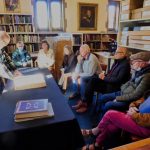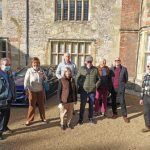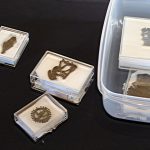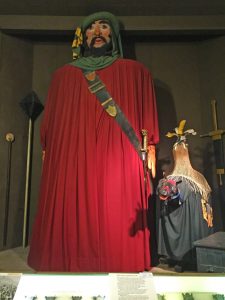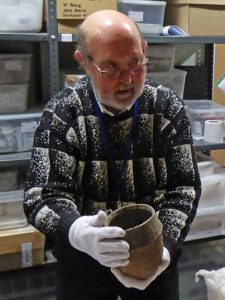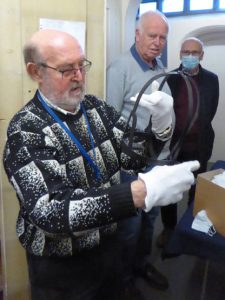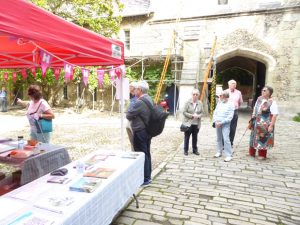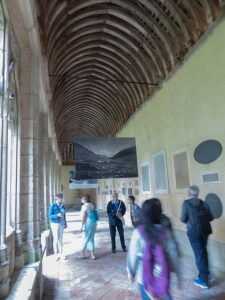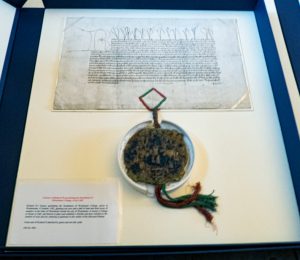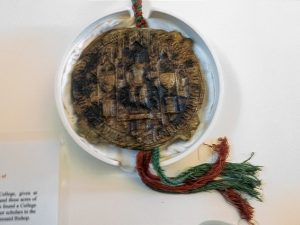Category Archives: Art, History and Architecture
AHA Group Visit: Behind the Scenes at Salisbury Museum
Eight members self-drove to Salisbury and met at the Museum café for coffee. We assembled in front of the museum for 11am when Roger our Guide joined us, and we commenced with the history of the building from the 13th century until its occupation by the museum in 1981.
We then moved on to explore the labyrinth of storerooms and corridors behind the exhibition areas. A vast array of items is kept as varied as a somewhat macabre Victorian toy to several thousand-year-old archaeological finds, which we were able to handle and view close-up. This provided us with an experience much more tactile and real than just seeing these items behind the glazed screens of the exhibition cabinets. It was quite bewildering learning of the volume of artifacts that the museum is holder of, not only in its rarity but the value relating to some of the raw material used in its creation.
The Group broke for lunch at the café, which was excellent and very good value.
Earlier our guide also discussed a lot about the history of Salisbury and why the Cathedral was moved from Old Sarum to establish Salisbury as we now know it. It is believed to be the first living space within the UK that created a drainage system (where to this day many items are still being discovered when repairs are in progress). The museum has created a new area dedicated to Salisbury History and some of us took advantage of this and found it most interesting. Over the years they have held various street parades exhibiting numerous things including the Giant Man, which represented the Taylors Guild as this played a big part in the local industry.
Also, the museum was holding a temporary exhibition “Cutting It Fine” – which is The Art of the British Wood Engraver. This artwork is created by using tools traditionally made for metal engraving, resulting in unbelievable levels of precision and fine detail in the production of prints from wood engravings. This exhibition goes on until January and is well worth a visit. Unable to show an example of the final product as print is copyright.
We would like to extend our thanks and good wishes to Roger for a very informative and enthusiastic guide, which was much enjoyed by all.
Our visit ended around 4pm, with our heads buzzing with new knowledge.
AHA Group Visit to Winchester Collage
Click/tap any picture to enlarge it
Once a year the National Heritage opens its doors for a period of two weeks through-out the country. When I say “opens its doors” this is because many of the venues are either private, a place of business, etc. and do not lean themselves for normal visiting. The range of properties encompasses every walk of life from historical, listed buildings to offices of public services and the list goes on and on.
This year the AHA Group concentrated on Winchester College, which was offering a variety of interests to visit. This took place whilst business was as usual – normal lessons for the scholars.
Winchester College was founded by William Long who became known as William of Wykeham which was his birthplace. He was born into a farming family and received a good education, and it became his passion that all children should be educated. Wykeham was made Bishop of Winchester and became known to many noble families along with a number of major building projects, i.e. Clerk of Works for the construction of Windsor Castle. He became well known within the inner circle of both Edward III and Richard II. Wykeham shared his wish to build a school in Winchester and his reasons for doing this, and the Kings gifted him the land.
At 11am nine of us commenced our tour of the College architecture, buildings, and the grounds, which is a maze of buildings spreading over time from 1389 to the current day. The quality of the architecture and the condition of buildings was outstanding and interesting.
It was made up of various courts stretching over a large area. This was quite a surprise as when you are standing in College Street looking at the front of the building, you would have no idea of its size. Once you reach the rear of the College there is a leisure section and a vast area devoted to a wide range of sport facilities.
In recent years they have created a Garden of Remembrance which is noted as being the largest private one within the U.K. This was formed to honour many of the College former pupils who are known as “Wykehamists”, who lost their lives serving in the armed forces from the First World War up to the present date.
After our outside walkabout, we peeked at the oldest parts of buildings which was the original Chapel currently being used mainly for archive storage.
Whilst here we enjoyed a double bonus as the College was showing an exhibition of the first Mount Everest Climb. With it being the one-hundred-year anniversary of the “Wykehamists” attempting to climb the region with the object of mapping, survey etc. This was led by a George Leigh-Mallory along with Major Henry Morshead and Guy Bullock. This was very informative showing a running film along with photographs, printed material and much more.
We then viewed a large room which was formerly the College Refectory. This was a typical room of its period with stained wooden panels, and over time names etc. has been etched in, now known as art! There were pictures and plaques of former principals etc. The room is now used as a quiet study room.
Following a break for lunch, we reassembled for our next treat, to listen to a Choir in Chapel I where we experienced a rehearsal by the younger pupils aged five to eight. This was a most enjoyable hour as the boys went through their repertoire for the coming Sunday first service. These boys only have had one week together with a couple of rehearsals. The harmony between the boys and their Choir Master / Music Teacher was exceptional and the wonderful sounds that were achieved were pure joy. On finishing rehearsal, the Choir Master then joined us for a chat, when he explained what had been achieved and what can be achieved given time.
It was now time to complete our visit to the College by viewing the Archives. The first building we had to climb 22 spiral steps up to a smallish room, and what was noticeable there was no heating and low natural light, but the walls were very thick. This constant temperature has played a big part in keeping the documents in pristine condition.
We were shown a number of documents, i.e. an inventory of what was required to take care of the King and his entourage on a visit in the 15th Century. For example, how many loaves of bread, gallons of beer – it made such interesting reading. But the highlight had to be looking at the deeds and seals of the land being gifted to Wykeham (in modern day terms we would say to fulfil his dream). These documents were so well preserved and looked very impressive. We then returned to Chapel II and those who were able climbed a further 55 steps to another archive with numerous records and artifacts. I believe records of all their scholars are stored here, but I was one of the faint hearted and gave the steps a miss!
The above concluded our tour of Winchester College and we were all feeling the need for a cup of tea, but also, we felt well informed and had had an enjoyable relaxed day. The day rounded off with an early dinner at the Abbots Mitre.
